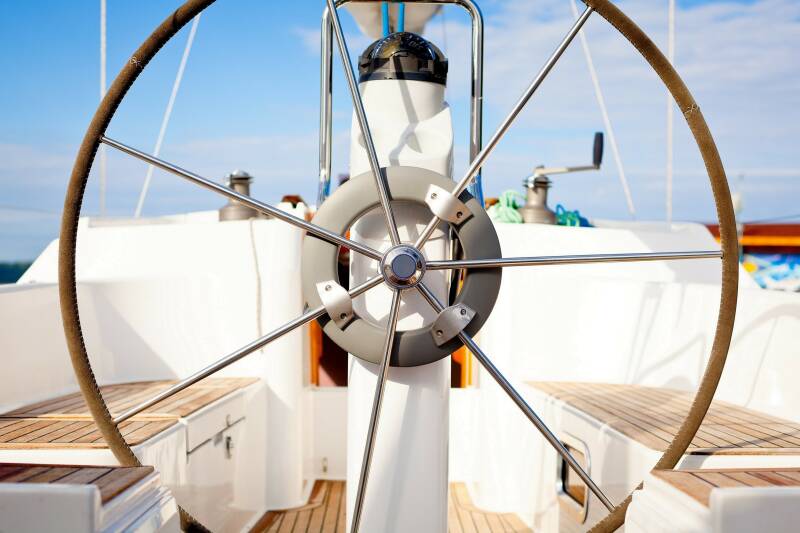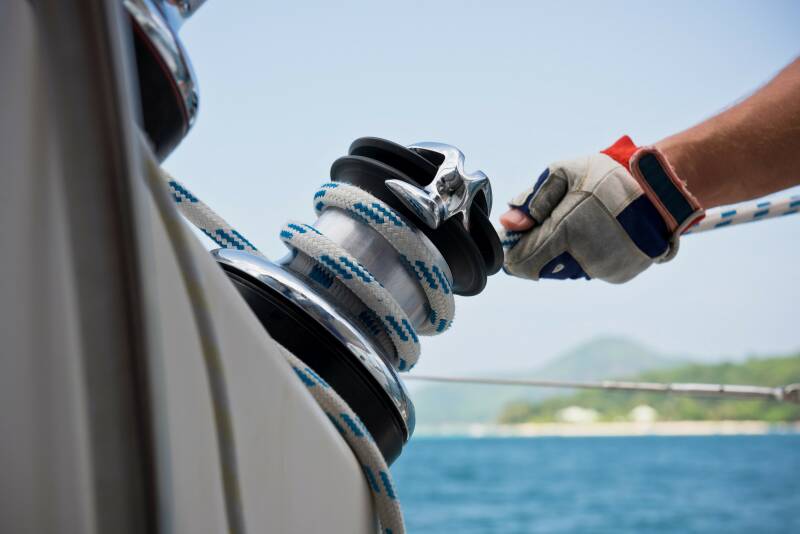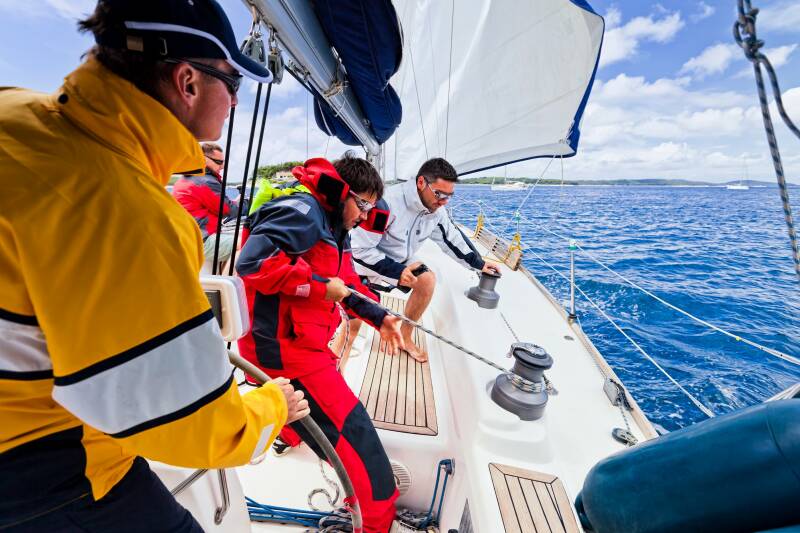In order to successfully accomplish your sailing week, you will need to learn a few yacht and sailing specific terms. Learning sailing terms will significantly improve your understanding of your skipper and other sailors that you will encounter along your voyage.
The Yacht Sailing Terms
- Berths/beds - a term used for a sleeping capacity of a yacht.
- Bimini - a weather-resistant fabric stretched over a stainless-steel frame, fastened above the cockpit of a sailboat or flybridge of a power yacht which serves as a rain or sunshade.
- Boom - the other pole that is connected to the mast under 90 degrees.
- Bow - the front part of the sailing yacht.
- Capsize - when a ship or boat lists too far and rolls over, exposing the keel. On large vessels, this often results in the sinking of the ship.
- Deckhand - a person whose job involves aiding the deck supervisor in (un)mooring, anchoring, maintenance, and general evolutions on deck.
- Draft - the depth of a ship's keel below the waterline.
- Galley - a term used for a kitchen on the yacht.
- Genoa sail - a front sail, located in between a mast and a bow of a yacht. It has the shape of a half balloon.
- Head - a toilet or latrine of a vessel.
- Helm - a steering wheel on a yacht, usually located at the stern.
- Keel - a central structural basis of the hull.
- Mast - a big “pole” that rises over a sailing yacht and holds a mainsail.
- Mainsail - a sail of a triangle shape, located in between a mast and a boom. Used for sailing into a harbour and for that reason is a main sail, but it is not the largest sail on a yacht.
- Moor - to attach a boat to a mooring buoy, post, or dock.
- Passarella - a little “bridge” on the stern which helps enter from a pier.
- Port side - when observing yacht from the helm, the left side of the yacht.
- Rudder - located beneath the boat, a flat piece of wood, fiberglass, or metal that is used to steer the ship (shape of a fin). Larger sailboats control the rudder with a wheel, while smaller sailboats will have a steering mechanism directly aft.
- Saloon - a central area in the yacht, with a galley, eating table, captain’s desk and sofas.
- Starboard side - when observing yacht from the helm, the right side of the yacht.
- Stern - the back part of the yacht.
- Winches - devices around which ropes are wrapped, used to lift sails and all kinds of heavy objects.
Terms While Sailing
- Apparent wind - during close hauled sailing into the wind, you will feel the wind into which you are sailing and the one that is created by the movement of your boat. That wind is called apparent wind.
- Beam Reach - at the point when the wind is filling sails under the angle of 90 degrees, we are in the beam reach position of sailing.
- Broad Reach - where the wind is entering our sails under the angle between 91 and 170 degrees, we are in the broad reach position and sailing downwind.
- Close Hauled - when wind is filling the sails under the angle of 45 degrees, we are in sailing close hauled position.
- Downwind - sailing in the same direction as the wind is blowing, or position in which wind is blowing into the stern of your sailing yacht.
- Heeling (leaning) - a lean caused by the wind's force on sails.
- Jibing - an opposite manoeuvre to tacking, performed when the stern of the yacht is pushed through the wind, so that wind changes from one side to another. Jibing is less performed than tacking since it is more dangerous and complex.
- Leeward - in the direction from which the wind is blowing towards the yacht.
- Reach - a point of sail from about 60° to about 160° off the wind. Reaching consists of "close reaching" (about 60° to 80°), "beam reaching" (about 90°) and "broad reaching" (about 120° to 160°).
- Reef - to temporarily reduce the area of a sail exposed to the wind, usually to guard against adverse effects of strong wind or to slow the vessel.
- Sheet - a rope used to control the setting of a sail in relation to the direction of the wind.
- Tacking - manoeuvring sailing yacht bow into the wind, so that the wind blowing direction changes from one side to the other, from starboard to port or vice versa.
- Vessel - a craft for traveling on water, usually a larger boat or ship.
Sailing Equipment Terms
- Drysuit – fully-closed suit protecting you from harsh conditions on the sea during rough weather.
- Life jacket – a personal flotation device, a piece of equipment designed to assist a wearer to keep afloat in water.
- Nautical charts - a graphic representation of a maritime area and adjacent coastal regions.
- Safety harness - a form of protective equipment wrapped around hips and quadriceps that is an attachment between a stationary (safety fence/lane around the sailing yacht) and non-stationary object (sailor). It is protection against falls from heights or a fall off the boat.
- Sailing gloves – very similar to cycling gloves by design (open-finger gloves), used to reduce impact of the friction between hands and ropes which you are holding while sailing.
- Sailing jacket, pants, boots, shoes – made of several materials which are wind- and waterproof. You can find a whole variety of equipment depending on the conditions in which you will be sailing.
- Sunglasses - they must have UV protection and it would be desirable to be polarized.
- Watches - main prerequisite is that the watch is waterproof
Commands
- Abandon Ship - an imperative to leave the vessel immediately, usually in the face of some imminent danger.
- Aye, aye - Aye, aye - reply to an order or command to indicate that it, firstly, is heard; and, secondly, is understood and will be carried out ("Aye, aye, sir" to officers).
- Let go and haul - an order indicating that the ship is in line with the wind.
- Man overboard - a cry let out when a seaman has gone overboard.
Pirate Terms
- Ahoy - hello
- All hands hoay - everyone gets on the deck
- Batten down the hatches - a signal to prepare the ship for an upcoming storm
- Coaming - a surface that prevented water on the deck from dripping to lower levels of the ship
- Cockswain - the helmsman
- Dance the hempen jig - to hang someone
- Duffle - sailor's belongings
- Heave ho - instruction to put some strength into whatever one is doing
- Holystone - a sandstone that was used to scrub ships
- Jacob's Ladder - a rope ladder that was used to climb aboard ships
- Jolly Roger - the famous pirate flag with skull and crossbones on it
- Landlubber - a person who is not incredibly skilled at sea
- Old salt - a sailor that has a great deal of experience on the seas
- Poop deck - a deck that is the highest and farthest back
- Seadog - an old sailor or pirate
- Three sheets to the wind - someone who is quite drunk
- Yo Ho Ho - often used to express some sort of cheer but can also be used to call attention to the speaker.












